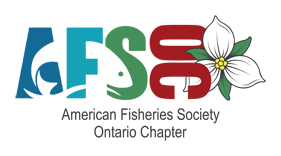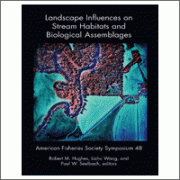Effects of Percent Impervious Cover on Fish and Benthos Assemblages and Instream Habitats in Lake Ontario Tributaries
AUTHOR(S): Les W. Stanfield, Bruce W. Kilgour
CITATION:
Stanfield, L.W. and B.W. Kilgour. 2006. Effects of percent impervious cover on fish and benthos assemblages and instream habitats in Lake Ontario tributaries. In: Landscape influences on stream habitats and biological assemblages. American Fisheries Society, Madison, WI. 48: 577-599. https://doi.org/10.47886/9781888569766.ch28
ABSTRACT:
We demonstrate the effects of percent impervious cover (PIC) on biophysical properties of Lake Ontario tributary streams. Biophysical data (fish assemblages, benthic invertebrate assemblages (benthos), instream physical habitat, and temperature) were collected from more than 575 wadeable stream sites.
A geographic information system application was developed to characterize the landscape upstream of each site (i.e., drainage area, surficial geology, land use/land cover, slope, stream length, and climate). Total PIC of catchments was estimated from land use/land cover, and a base flow index was derived from the surficial geology. The relationship between PIC and biophysical responses was determined after statistically removing the effects of natural landscape features (i.e., catchment area, slope, base flow index) on those responses. Contrasts in PIC from natural conditions (<3% to 10%) were related to variations in fish and benthos assemblages. Both coldwater sensitive and warmwater tolerant fish and diverse benthos assemblages were found in catchments with low PIC. At more than 10 PIC (i.e., about 50% urban), both fish and benthos consisted of mainly warmwater or tolerant assemblages. For example, trout were absent and minnows were dominant. While some of the apparent PIC effect may have been confounded by land use/land cover and surficial geology, the consistency of the findings even after natural catchment conditions were considered suggests that the threshold response is valid. Percent impervious cover had a weaker effect on instream geomorphic variables than on biological variables. The models derived from this study can be used to predict stream biophysical conditions for catchments with varying levels of development.
FULL TEXT – Stanfield and Kilgour


